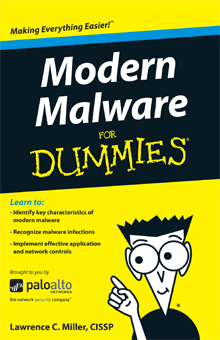Modern Malware for Dummies!
Malware is malicious software or code that typically damages or disables, takes control of, or steals information from a computer system. Malware broadly includes botnets, viruses, worms, Trojan horses, logic bombs, rootkits, boot-kits, back-doors, spyware, and adware.
Introduction
Modern malware has transformed into highly sophisti-cated network applications and has, in the process,changed the world of enterprise security and how networks are attacked. These threats are experts at remaining hidden from traditional security while exhibiting an intelligence,resiliency, and scale that has never before been seen in malware. Controlling these threats will require multiple security disciplines. While no single solution will solve the problem of networked malware on its own, the next-generation firewall provides the unique visibility and control of, and the true integration of, threat-prevention disciplines needed to find and stop these threats — both known and unknown.
About This Post
This Post provides an in-depth examination of real-world
attacks and modern malware threats, the shortcomings of
legacy security solutions, the capabilities of next-generation
firewalls, and security best practices.
What's contained in this post?
1: Understanding the Modern Threat Landscape
2: Defining Modern Malware
3: Why Traditional Security Solutions Fail to Control Modern Malware
4: What the Next-Generation Firewall Brings to the Fight against Malware
5: Creating Modern Malware Protection Policies
6: Ten Best Practices for Controlling Modern Malware
1: Understanding the Modern Threat Landscape
For many years, the security industry was seen as Chicken Little, telling anyone who would listen that “the sky was falling” and that hackers were trying to steal their most precious information. For the most part, that simply wasn’t the case. Hackers were largely creatures of opportunity seeking the path of least resistance — if they encountered a secured network, they were likely to move on, looking for a softer target. Today’s hackers are highly motivated, professional cyber criminals — often well-funded by criminal organizations or rogue nation-states — that are far more patient and persistent in their efforts to break through an organization’s defenses.
2: Defining Modern Malware
The rise of modern malware is reshaping the threat landscape and forcing enterprises to reassess how they protect themselves. Collectively, modern malware has outpaced traditional anti-malware strategies and in the process, has established a foothold within the enterprise that criminals and nation-states can use to steal information and attack sensitive assets.
3: Why Traditional Security Solutions Fail to Control Modern Malware
Today’s application and threat landscape renders traditional port-based firewalls and other security solutions largely ineffective at protecting corporate networks.
4: What the Next-Generation Firewall Brings to the Fight against Malware
The next-generation firewall provides arguably the most important weapon in the fight against modern malware —the reliable visibility and control of all traffic on the network,irrespective of port or evasive tactics that may be employed.
5: Creating Modern Malware Protection Policies
Far too often, technical solutions are implemented without considering the implications for an organization’s over-all security strategy. To avoid this mistake, it is important to ensure that your policies are up to date and the technology solutions you are considering support a comprehensive security strategy.
6: Ten Best Practices for Controlling Modern Malware
- Ensure Visibility into All Traffic
- Restrict High-Risk Applications
- Selectively Decrypt and Inspect SSL Traffic
- Sandbox Unknown Executables and Attachments
- Block URLs That Are Known to Host Malware
- Enforce Drive-by-Download Protection
- Block Known Exploits and Malware
- Limit Traffic for Common Applications to Default Ports
- Investigate Unknowns
If YOU want a copy:::https://www.scribd.com/document/79196725/eBook-Palo-Alto-Security-for-Dummies
Hope YOU find it USEFUL, IF u .....FOLLOW......RESTEEM......UPVOTE

Upvoted :) Can you please do the same? Thanks https://steemit.com/steemit/@cryptomonitor/ready-for-7-inch-windows-laptop
thanks for reading...:::https://steemit.com/earn/@suraj/make-some-money-from-apps